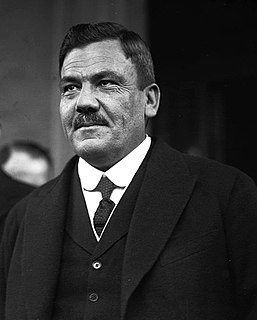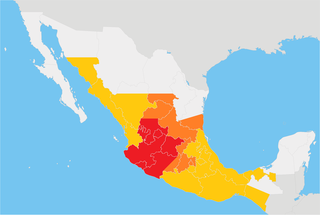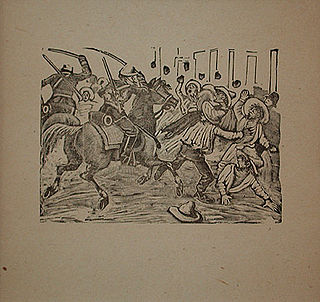
Plutarco Elías Calles was a Mexican military general and politician. He was the powerful interior minister under President Álvaro Obregón, who chose Calles as his successor. The 1924 Calles presidential campaign was the first populist presidential campaign in Mexico's history, as he called for land redistribution and promised equal justice, more education, additional labour rights, and democratic governance.
Anti-clericalism is opposition to religious authority, typically in social or political matters. Historical anti-clericalism has mainly been opposed to the influence of Roman Catholicism. Anti-clericalism is related to secularism, which seeks to separate the church from public and political life.

The Constitution of Mexico, formally the Political Constitution of the United Mexican States, is the current constitution of Mexico. It was drafted in Santiago de Querétaro, in the State of Querétaro, by a constituent convention, during the Mexican Revolution. It was approved by the Constituent Congress on 5 February 1917. It is the successor to the Constitution of 1857, and earlier Mexican constitutions.

State atheism is the incorporation of positive atheism or non-theism into political regimes. It may also refer to large-scale secularization attempts by governments. It is a form of religion-state relationship that is usually ideologically linked to irreligion and the promotion of irreligion to some extent. State atheism may refer to a government's promotion of anti-clericalism, which opposes religious institutional power and influence in all aspects of public and political life, including the involvement of religion in the everyday life of the citizen. In some instances, religious symbols and public practices that were once held by religion were replaced with secularized versions. State atheism can also exist in a politically neutral fashion, in which case it is considered as non-secular.

The Cristero War, also known as the Cristero Rebellion or La Cristiada[la kɾisˈtjaða], was a widespread struggle in central and western Mexico in response to the imposition of secularist and anticlerical articles of the 1917 Constitution of Mexico, which were perceived by opponents as anti-Catholic measures aimed at imposing state atheism. The rebellion was instigated as a response to an executive decree by Mexican President Plutarco Elías Calles to enforce Articles 3, 5, 24, 27, and 130 of the Constitution, a move known as the Calles Law. Calles sought to eliminate the power of the Catholic Church and all organizations which were affiliated with it and to suppress popular religious celebrations in local communities.

José Ramón Miguel Agustín Pro Juárez, also known as Blessed Miguel Pro, was a Mexican Jesuit Catholic priest executed under the presidency of Plutarco Elías Calles on charges of bombing and attempted assassination of former Mexican President Álvaro Obregón.

Anti-Catholicism is hostility towards Catholics or opposition to the Catholic Church, its clergy, or its adherents. At various points after the Reformation, some majority Protestant states, including England, Prussia, and Scotland made anti-Catholicism and opposition to the Pope and Catholic rituals major political themes, and the anti-Catholic sentiment which resulted from it frequently lead to religious discrimination against Catholic individuals. Historian John Wolffe identifies four types of anti-Catholicism: constitutional-national, theological, popular and socio-cultural.

Tomás Garrido Canabal was a Mexican politician, revolutionary and atheist activist. Garrido Canabal served as dictator and governor of the state of Tabasco from 1920 to 1924 and again from 1931 to 1934, and was particularly noted for his anti-Catholicism. During his term he fiercely persecuted the Church in his state, killing many priests and laymen and driving the remainder underground.

The Red Shirts were a paramilitary organization, existing in the 1930s, founded by the atheist and anti-Catholic anticlerical Governor of Tabasco, Mexico, Tomás Garrido Canabal, during his second term. As part of their attempt to destroy the Church, they systematically destroyed church buildings. The group, created to carry out the governor's orders, takes its name from its uniform of red shirts, black pants, and black and red military caps. It consisted of men and women aged 15 to 30.
The Calles Law, or Law for Reforming the Penal Code, was a statute enacted in Mexico in 1926, under the presidency of Plutarco Elías Calles, to enforce the restrictions against the Catholic Church in Article 130 of the Mexican Constitution of 1917. Article 130 declared that the church and state are to remain separate. To that end, it required all "churches and religious groupings" to register with the state and placed restrictions on priests and ministers of all religions. Priests and ministers could not hold public office, canvass on behalf of political parties or candidates, or inherit property from persons other than close blood relatives. President Calles applied existing laws regarding the separation of church and state throughout Mexico and added his own legislation.

Enrique Gorostieta Velarde was a Mexican soldier best known for his leadership as a general during the Cristero War.
Anacleto González Flores was a Mexican Catholic layman and lawyer who was tortured and executed during the persecution of the Catholic Church under Mexican President Plutarco Elías Calles.
Iniquis afflictisque is an encyclical of Pope Pius XI promulgated on November 18, 1926, to denounce the persecution of the Catholic Church in Mexico. It was one of three encyclicals concerning Mexico, including Acerba animi (1932) and Firmissimam Constantiamque (1937). The Mexican government at the time was engaging in violently anticlerical persecution of the Church and the Pope harshly criticised the government for its abuses.

The history of the Catholic Church in Mexico dates from the period of the Spanish conquest (1519–21) and has continued as an institution in Mexico into the twenty-first century. Catholicism is one of the two major legacies from the Spanish colonial era, the other being Spanish as the nation's language. The Catholic Church was a privileged institution until the mid nineteenth century. It was the sole permissible church in the colonial era and into the early Mexican Republic, following independence in 1821. Following independence, it involved itself directly in politics, including in matters that did not specifically involve the Church.

Irreligion in Mexico refers to atheism, deism, religious skepticism, secularism, and secular humanism in Mexican society, which was a confessional state after independence from Imperial Spain. The first political constitution of the Mexican United States enacted in 1824, stipulated that Roman Catholicism was the national religion in perpetuity, and prohibited any other religion. Moreover, since 1857, by law, Mexico has had no official religion; as such, anti-clerical laws meant to promote a secular society, contained in the 1857 Constitution of Mexico and in the 1917 Constitution of Mexico limited the participation in civil life of Roman Catholic organizations, and allowed government intervention to religious participation in politics.

The Catholic Church in Latin America began with the Spanish colonization of the Americas and continues up to the present day.
The question of whether Freemasonry is anticlerical is the subject of debate. The Catholic Church has long been an outspoken critic of Freemasonry, and some scholars have often accused the fraternity of anticlericalism. The Catholic Church forbids its members to join any Masonic society under pain of interdiction. Freemasons usually take a diametrically opposite view, stating that there is nothing in Freemasonry that is in any way contrary to Catholicism or any other religious faith.
The Mexican Catholic Apostolic Church Spanish: Iglesia Católica Apostólica Mexicana (ICAM) was founded in 1925, by separation from the Catholic Church in Mexico. It was created to bolster revolution and cause a schism with the Catholic Church in Mexico with the support of the Regional Confederation of Mexican Workers (CROM) and Mexican President Plutarco Elías Calles' approval. Its development was marked by several internal crises, followed by consequent splits and mergers. Since 1993, it has been officially listed in the Mexican Federal Registry of Religious Associations.

National League for the Defense of Religious Liberty or National League for the Defense of Religious Freedom was a Mexican Catholic religious civil rights organization formed in March 1925 that played a crucial role in the Cristero War of 1926–1929. The Mexico City-based organization was created by former members of the short-lived National Catholic Party, the Union of Mexican Catholic Ladies ; a student organization, the Jesuit-led Catholic Association of Mexican Youth ; the Knights of Columbus; the National Parents' Association; and the National Catholic Labor Confederation. The League had by June of its founding year about 36,000 members and chapters in almost every state of the country. The organization arose after the anti-clerical provisions of the 1917 Mexican Constitution were strictly enforced by the fiercely anti-Catholic President Plutarco Calles and after he enacted further draconian provisions in the Calles Law.
Acerba animi is an encyclical of Pope Pius XI promulgated on 29 September 1932, to denounce the continued persecution of the Catholic Church in Mexico. It was the second of three encyclicals concerning persecution in Mexico, including Iniquis afflictisque (1926) and Firmissimam constantiamque (1937). The Mexican government at the time was engaging in violently anticlerical persecution of the Church, and the Pope harshly criticised the government for its past and current abuse of the Church and its faithful and chided the government for not only violating its promises to the Church made in the recent cessation of the Catholic uprising, the Cristero War, but expanding the persecution.












